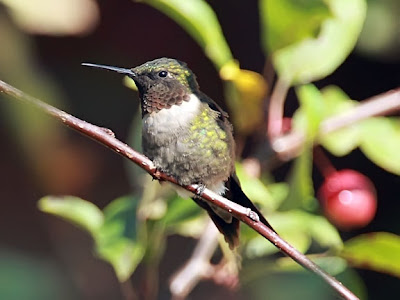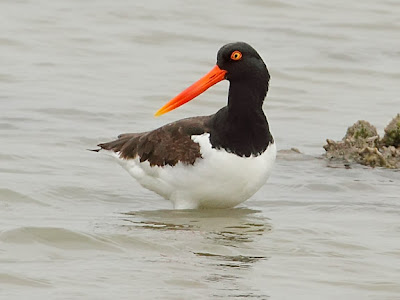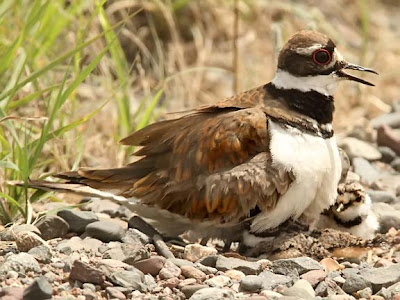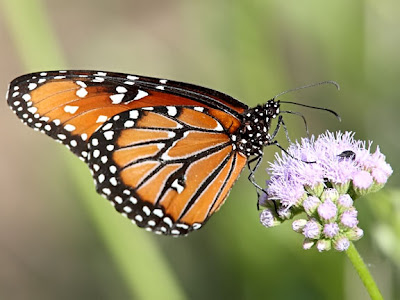The clay-colored sparrow is an Emberizine, or new world, sparrow that lives in the central portions of North America. Their breeding range includes the north central portion of the United States, from Montana through Michigan, and central Canada. Their individual breeding territory is smaller then most other Passerine species, so they are often found foraging outside their territory during the breeding season. Clay-colored sparrows typically forage close to the ground and eat primarily grass seeds, though they will also eat insects. They tend to feed their young primarily insects. During the winter these sparrows migrate south to Mexico and Central America where they are often found in mixed flocks with other species of sparrows.
Tuesday, July 31, 2012
Monday, July 30, 2012
Tuesday Tweets
The ruby-throated hummingbird is the only species of humming bird that breeds in eastern North America. Their breeding range extends from the Atlantic coast out to the central portions of the continent and is the largest breeding range of any hummingbird in North America.Unlike most other small birds hummingbirds are not members of the order Passeriformes, or passerines. Hummers are actually part of the order Apodiformes, which translated from Latin means "footless". Hummers have very small legs that are covered with skill instead of scales like most other birds. Their small feet are only good for perching, they are not able to walk or jump. Hummers have relatively long wings with a short humerus bone, this give enables them to hover in place, their wings beating approximately 53 times per second.
Welcome to Tuesday Tweets! To join in the fun just post a photo of a bird and then link it by here by using the handy dandy link below. Then make sure you visit other sites to do a little bird watching.
Welcome to Tuesday Tweets! To join in the fun just post a photo of a bird and then link it by here by using the handy dandy link below. Then make sure you visit other sites to do a little bird watching.
Sunday, July 29, 2012
Phantom Crane Fly
The phantom crane fly is a member of the Ptychopteridae family. They are usually found around wetlands where they lay their eggs. The larva are aquatic and live for about a month before they form a pupae, which they emerge from about 10 days later. In flight the phantom crane fly extend its legs allowing it to float on the wind kind of like a hand glider.
Saturday, July 28, 2012
Barrow's Goldeneye
I photographed these Barrow's goldeneye ducks in Yellowstone. While most Barrow's goldeneye are found in the northwestern portions of North America there is also a population in Iceland. It was the birds in Iceland that were first described and named after Sir John Barrow.
Friday, July 27, 2012
Big Horn Ram
It is believed that the sheep of North America originated in Asia and crossed the Bering Straight approximately 750,000 years ago. After about 150,000 years these Snow Sheep from Siberia evolved into two separate North American species, Dall sheep in Alaska and western Canada and big horned sheep in the western half of the United States. The big horned sheep is further divided into three subspecies, the desert bighorn which is found in Mexico and the southwestern United States, the Sierra Nevada which are found in the Sierra Nevada Mountains, and the Rocky Mountain bighorn which is found in the Rockies. This ram is a Rocky Mountain big horn and was photographed at Yellowstone National Park.
Thursday, July 26, 2012
Gooseberry Falls
This is a part of the middle falls of Gooseberry Falls. The last time I was here this was the main channel that the water flowed over on its way down to lake Superior. Changes in water levels and natural obstructions have diverted much of the water down another path about 10 feet to the east. The light flow of water pouring down at this location formed a nice little rainbow .
Wednesday, July 25, 2012
Tuesday, July 24, 2012
Bullock's Oriole
The Bullock's oriole is a colorful member of the Icteridae, blackbird, family found in the western half of North America. The Bullock's oriole was named after William Bullock who was an English born collector and amateur naturalist. On a trip to Mexico he shot a Bullock's oriole and brought it back to professional naturalist and birder William Swainson who named the species after Bullock.
For a while the Bullock's oriole and the Baltimore oriole were combined into a single species called the northern oriole. This was primarily due to the fact that the two species do hybridize with one and other where their ranges over lap in the central portion of North America. However DNA testing revealed that the two species are not very similar so they were broken back up into two separate species.
For a while the Bullock's oriole and the Baltimore oriole were combined into a single species called the northern oriole. This was primarily due to the fact that the two species do hybridize with one and other where their ranges over lap in the central portion of North America. However DNA testing revealed that the two species are not very similar so they were broken back up into two separate species.
Monday, July 23, 2012
Tuesday Tweets
The American oystercatcher lives in the coastal waters of North, South and Central America. In North America the American Oystercatcher is divided into two separate populations. The Atlantic birds range New England down through out the Atlantic Coast and the west across the Gulf Coast and into Texas, which is where I photographed this bird. The Pacific birds range from Baha California down the Pacific coast of Mexico and into the coastal waters of Central America. Oystercatcher can usually be sound searching in the surf for marine invertebrates to eat. Their large thick beak is an excellent tool for prying open oyster shells which is how they got their name.
Welcome to Tuesday Tweets! To join in
the fun just post a photo of a bird and then link it by here by using the handy
dandy link below. Then make sure you visit other sites to do a little bird
watching.
Sunday, July 22, 2012
Bee with Full Pollen Sacks
I photographed this bee at the Resaca de la Palma in south Texas. The yellow powder on the under side of the bee is pollen and if you look closely at the rear leg of the bee you will notice a full pollen sack. The bee will take the pollen back to the hive where it will be made into honey. The bees use the honey to feed the young and store it to eat as food, for times that flower nectar is not available.
Saturday, July 21, 2012
Friday, July 20, 2012
Belted Kingfisher
So what do belted kingfishers have in common with bank swallows and burrowing owls? The belted kingfisher, like the other two for-mentioned species, nests underground. They dig a burrow in the bank of a river or creek. At first they use their strong beak to chip away at the dirt and mud of the bank. Once they have a burrow started they will flying into it and kick out the loose soil with their feet. The tunnel is usually from 3 to 8 feet long and slopes up so that the burrow is less likely to get flooded. Human activity, such as road construction and gravel pits, has actually helped to increase the amount of available nesting habitat for these birds.
Thursday, July 19, 2012
Golden Cranes
Wednesday, July 18, 2012
Tuesday, July 17, 2012
American Avocet
The American avocet is a shorebird that nests in the wetlands of central North America. They can be found from New Mexico and western Texas in the south, north up into Canada. During the breeding season they become more colorful with some of their feathers become a salmon color. While they are on their winter grounds, in Florida, Mexico and parts of the Caribbean they are just black and white.
The Picture and video were both taken at Bowdoin National Wildlife Refuge in Montana in May.
Labels:
ABC Wednesday,
avocet,
Tuesday Tweets,
World Bird Wednesday
Monday, July 16, 2012
Tuesday Tweets
The blue-headed vireo was once called the solitary vireo. However after some study the solitary vireo was divided into three distinct species. The plumbeous, Cassin's, and blue-headed vireo. The blue-headed vireo has a more easterly range then the other two species, with a breeding range through out the eastern two thirds of Canada and the north eastern United States. They winter in Mexico, Central America, and along the Gulf coast. This one stopped by for a few days during the spring migration.
Welcome to Tuesday
Tweets! To join in the fun just post a photo of a bird and then link it by here
by using the handy dandy link below. Then make sure you visit other sites to do
a little bird watching.
Sunday, July 15, 2012
Variegated Meadohwawk
The variegated meadowhawk is one of the few migratory dragonflies that we have here in Minnesota. Usually we see a few in the spring and a few in the fall as they are migrating through but last weekend I found hundreds on a beach at Upper Red Lake.
Like most meadowhawks the male and female are different colors. The males are predominantly red, like many of the other species of meadowhakws, however the female variegated meadowhawk is mostly silver and white which is an unusual color scheme for a meadowhawk.
Each year these dragonflies participate in a one way migration. Mature dragonflies fly south, some as far as the Honduras. There they will mate and lay their eggs before they die. It is their offspring that will begin the trip back to the north some arriving in Minnesota as early as April and May. These pictures where taken in New Mexico last November.
Like most meadowhawks the male and female are different colors. The males are predominantly red, like many of the other species of meadowhakws, however the female variegated meadowhawk is mostly silver and white which is an unusual color scheme for a meadowhawk.
Each year these dragonflies participate in a one way migration. Mature dragonflies fly south, some as far as the Honduras. There they will mate and lay their eggs before they die. It is their offspring that will begin the trip back to the north some arriving in Minnesota as early as April and May. These pictures where taken in New Mexico last November.
Saturday, July 14, 2012
Friday, July 13, 2012
Thursday, July 12, 2012
Wednesday, July 11, 2012
Subscribe to:
Comments (Atom)



















































